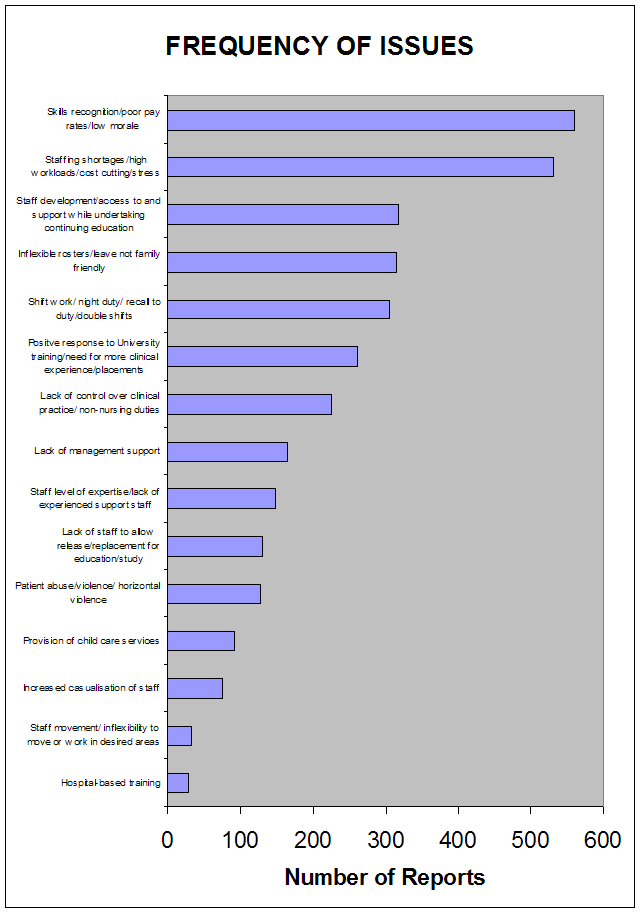Appendix 3 - Issues raised in submissions responding to ANF questionnaire
The ANF and some State branches circulated a questionnaire
based on the Committee’s terms of reference to its members for completion and
submission to the Committee. The Committee received 658 submissions from
individual nurses in response to this questionnaire.
The questions contained in this questionnaire are listed
below, although there was some variation across the States in which questions
were used.
Q1. Briefly
describe your current work situation, and factors impacting on the working
lives of nurses. (Qld, Vic, ACT, Tas)
Q2. What
strategies do you think would assist in the recruitment and retention of
nurses? (Qld, Vic, ACT, Tas)
Q3. What
changes do you think would assist the interface between universities and the
health system and better prepare nurses to meet future labour force needs?
(Tas)
Q4. What
has been successfully introduced recently to improve the recruitment and
retention of nurses? (Vic)
Q5. What
is still wrong with the system? (Vic)
Q6. What
else can be done to address these shortfalls (eg education, scholarships)?
(Vic).
The following information provides a listing of the general
issues and concerns most commonly expressed by the nurses in response to the
questionnaire, together with a profile of the respondents by area of practice,
nursing specialty, length of nursing service and years they expect to remain in
nursing.
|
General
issues/concerns most commonly expressed in nurse responses
|
No.
|
%
|
|
Skills recognition/poor pay rates/low morale
|
559
|
85.0%
|
|
Staffing shortages/high workloads/cost-cutting/stress
|
531
|
80.7%
|
|
Staff development/access to and support while
undertaking continuing education
|
318
|
48.3%
|
|
Inflexible rosters/leave not family friendly
|
316
|
48.0%
|
|
Shift work/night duty/recall to duty/double shifts
|
305
|
46.4%
|
|
Positive response to University training/need for more
clinical experience/placements
|
261
|
39.7%
|
|
Lack of control over clinical practice/non-nursing
duties
|
225
|
34.2%
|
|
Lack of management support
|
164
|
24.9%
|
|
Staff level of expertise/lack of experienced staff
support
|
149
|
22.6%
|
|
Lack of staff to allow release/replacement for
education/study
|
130
|
19.8%
|
|
Patient abuse/violence/horizontal violence
|
127
|
19.3%
|
|
Provision of child care services
|
92
|
14.0%
|
|
Increased casualisation of staff
|
76
|
11.6%
|
|
Staff movement/inflexibility to move or work in
desired areas
|
32
|
4.9%
|
|
Hospital-based training
|
28
|
4.3%
|
|
Total number of respondents
|
|
658
|

Profile of nurses who responded to the questionnaire
Location of Practice
|
Hospital/
nursing location
|
City
|
Regional
|
Rural/
Remote
|
Unstated
|
Total
|
|
Total for each area
|
362
|
171
|
87
|
38
|
658
|
|
Percentage
|
55.1%
|
26.0%
|
13.2%
|
5.6%
|
100%
|
Nursing position
|
Nursing speciality
|
Clinical
|
Community
|
Aged Care
|
Educator
|
Other
|
Unstated
|
Total
|
|
|
472
|
77
|
70
|
10
|
15
|
13
|
658
|
|
Percentage
|
71.8%
|
11.7%
|
10.7%
|
1.5%
|
2.3%
|
2.0%
|
100.0%
|
Length of nursing
service
|
Years in nursing
|
0 to 5
|
6 to 10
|
11 to 20
|
>20
|
Unstated
|
Total
|
|
Respondents
|
33
|
59
|
182
|
361
|
22
|
658
|
|
Percentage
|
5.0%
|
9.0%
|
27.7%
|
54.9%
|
3.3% |
100%
|
Years expected to remain
in nursing
|
Years expecting to remain in
nursing
|
0 to 5
|
6 to 10
|
11 to 20
|
>20
|
Unstated
|
Total
|
|
Totals
|
170
|
148
|
149
|
34
|
157
|
658
|
Navigation: Previous Page | Contents | Next Page